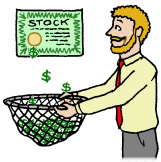The dividend yield and how to use it when analysing companies
 The dividend yield has some major advantages when valuing stocks.
The dividend yield has some major advantages when valuing stocks.
It is very easy to work out and it lets us look at the fundamental reason for investing which is a return on our investment. Unlike earnings, dividends are actual cash flows into our very own bank accounts. They are real returns that are available to investors with added incentives.
There are, of course, some shortcomings, though, and the first of these is that, unlike the PER, the dividend yield doesn’t factor anything in for growth. We would need to factor in the growth aspects ourself. One way to do this and often the simplest is to assume that a stock’s dividend yield remains at its current level. To keep the dividend yield at the same level, the stock price must grow at the same rate as the dividend. Therefore our total return will equal the dividend yield plus the rate of dividend growth.
Lets look at an example :
If a share has a dividend yield of 5% now, and we expect the dividend to grow at 6% a year, then we’d expect to make a return of 11% a year, and if we edged up our expectations for dividend growth to 8% a year, then we’d expect a return of 13% a year. Alternatively if a share provided a dividend this year of $1 and we expected this to grow at 6% a year, then if we wanted a return of 10% a year, we’d need a dividend yield of 4%—giving us a value for the share of $25. And if we were aiming for a return of 14%, then we’d need the same share to provide a dividend yield of 8%, thereby halving our value to $12.50. This gives us some reference points in theory. Of course in the real world this is just a starting price and we need to take into account other factors to come up with a realistic value for the company. There are a few other things to look out for with dividends. Importantly you should only really be looking for a company’s ‘ordinary’ dividends, rather than any ‘special’ dividends (which tend to be one-off). Secondly, and perhaps most importantly is to bear in mind that dividends are just numbers chosen by the directors. In some cases, an overoptimistic assessment of the future will lead to them being set at too high a level and they’ll actually need to be reduced. If you think that’s the case, then you’ll need to make your own adjustment downwards to a level you think is sustainable (and indeed might allow for a little growth). One way of checking this is to check the payout ratio from year to year of the company. If you find it is going up but the dividends are declining or staying the same then there is a good chance that the company will not be able to keep the current level of dividends. On the other hand if you see a company's payout ratio go down and the dividend remain steady or go up then you know the company will be finanically stable to increase the dividend in future years.
There are a few other things to look out for with dividends. Importantly you should only really be looking for a company’s ‘ordinary’ dividends, rather than any ‘special’ dividends (which tend to be one-off). Secondly, and perhaps most importantly is to bear in mind that dividends are just numbers chosen by the directors. In some cases, an overoptimistic assessment of the future will lead to them being set at too high a level and they’ll actually need to be reduced. If you think that’s the case, then you’ll need to make your own adjustment downwards to a level you think is sustainable (and indeed might allow for a little growth). One way of checking this is to check the payout ratio from year to year of the company. If you find it is going up but the dividends are declining or staying the same then there is a good chance that the company will not be able to keep the current level of dividends. On the other hand if you see a company's payout ratio go down and the dividend remain steady or go up then you know the company will be finanically stable to increase the dividend in future years.
Remember this is only one part of analysing a company but it can be a very important part as dividends provide a real return while you are holding the stock. You don't need to sell the share to get the benefit.
Good Luck.

No comments:
Post a Comment